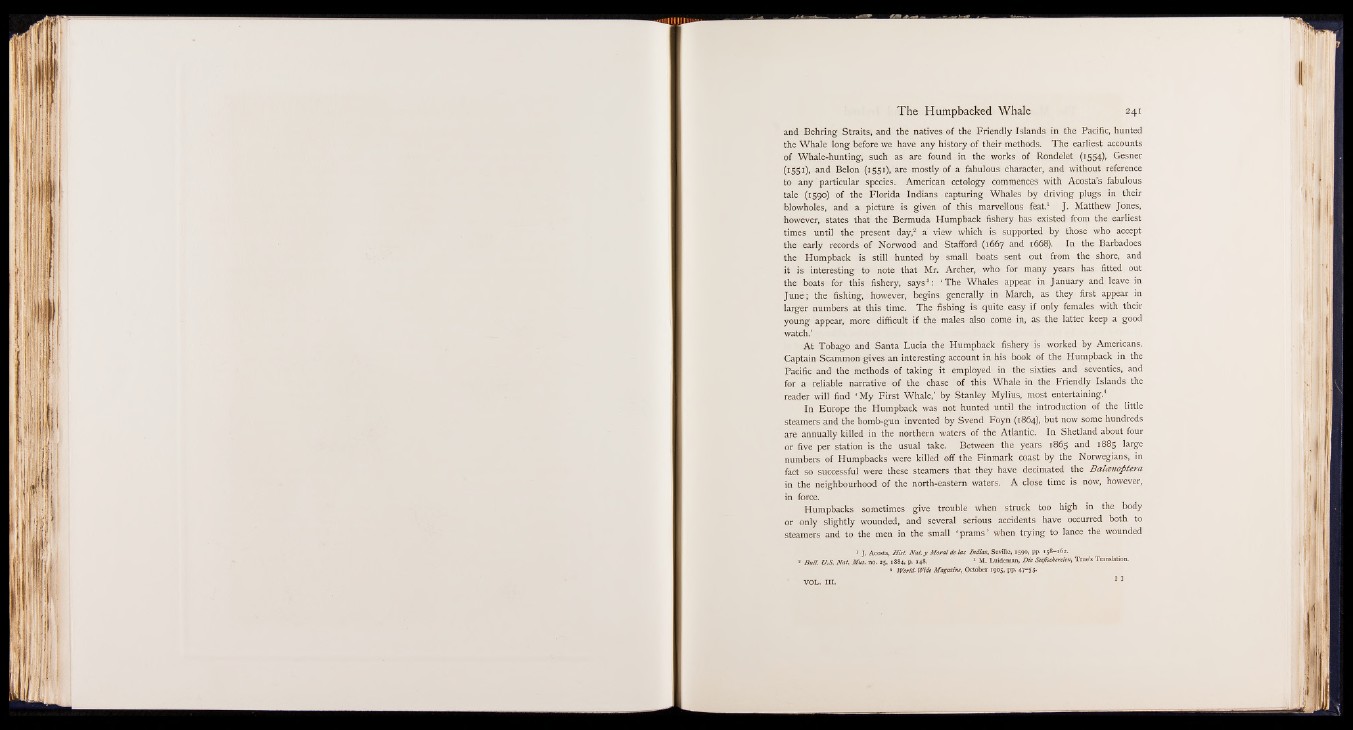
and Behring Straits, and the natives of the Friendly Islands in the Pacific, hunted
the Whale long before we have any history of their methods. The earliest accounts
of Whale-hunting, such as are found in the works of Rondelet (i554)> Gesner
(1551), and Belon (1551), are mostly of a fabulous character, and without reference
to any particular species. American cetology commences with Acosta’s fabulous
tale (1590) of the Florida Indians capturing Whales by driving plugs in their
blowholes, and a picture is given of this marvellous feat.1 J. Matthew Jones,
however, states that the Bermuda Humpback fishery has existed from the earliest
times until the present day,2 a view which is supported by those who accept
the early records of Norwood and Stafford (1667 and 1668). In the Barbadoes
the Humpback is still hunted by small boats sent out from the shore, and
it is interesting to note that Mr. Archer, who for many years has fitted out
the boats for this fishery, says8: ‘ The Whales appear in January and leave in
June; the fishing, however, begins generally in March, as they first appear in
larger numbers at this time. The fishing is quite easy if only females with their
young appear, more difficult if the males also come in, as the latter keep a good
watch.’
At Tobago and Santa Lucia the Humpback fishery is worked by Americans.
Captain Scammon gives an interesting account in his book of the Humpback in the
Pacific and the methods of taking it employed in the sixties and seventies, and
for a reliable narrative of the chase of this Whale in the Friendly Islands the
reader will find ‘ My First Whale,’ by Stanley Mylius, most entertaining.4
In Europe the Humpback was not hunted until the introduction of the little
steamers and the bomb-gun invented by Svend Foyn (1864), but now some hundreds
are annually killed in the northern waters of the Atlantic. In Shetland about four
or five per station is the usual take. Between the years 1865 and 1885 large
numbers of Humpbacks were killed off the Finmark coast by the Norwegians, in
fact so successful were these steamers that they have decimated the Balamoptera
in the neighbourhood of the north-eastern waters. A close time is now, however,
in force.
Humpbacks sometimes give trouble when struck too high in the body
or only slightly wounded, and several serious accidents have occurred both to
steamers and to the men in the small ‘ prams’ when, trying to lance the wounded
1 J. Acosta, H ist. Nat. y Moral de las Indias, Seville, 1590, pp. 158-162.
8 B u ll. U.S. Nat. Mus. no. 25, 1884, p. 148. 3 M. Luideman, D ie Seefisehereitn, True’s Translation.
* World-Wide Magazine, October 1905, pp. 47~S3-
I I VOL. III.